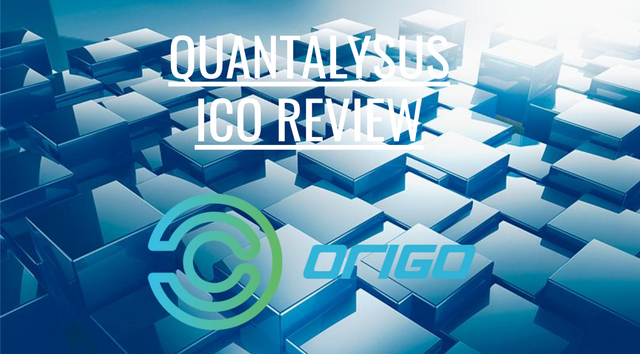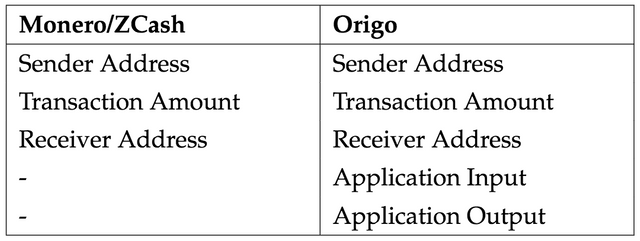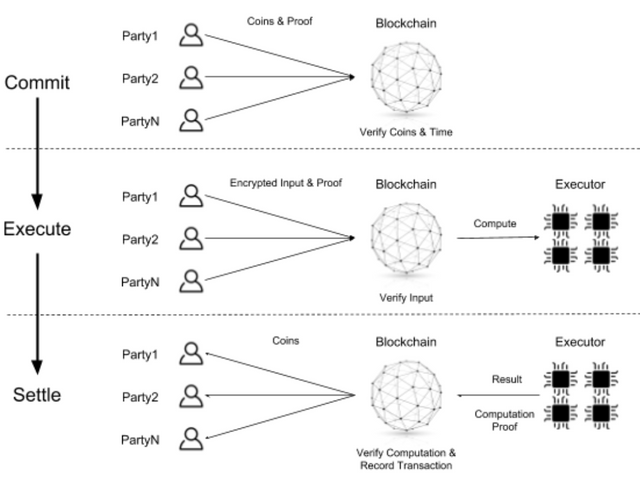ICO Preview: Origo Network

Origo aims to create a smart contract enabled blockchain platform with strong privacy features. Similar to Loki Network, Edenchain, and upcoming project Aergo, Origo Network aims to feature privacy as one of the main drivers of adopting decentralized applications (dApps). Nowhere is the need for privacy more paramount than in the collection of identity and behavior data. In the June 2nd, 2018 edition of The Economist titled The Surveillance State: Perfected in China, a Threat in the West, the front cover story discusses why privacy deterrent technologies are necessary. Scandals including Facebook's recent Cambridge Analytica debacle nosedived the behemoth's reputation and market cap. Investors, businesses, and users alike would be well informed to balance the need for privacy and profits. While Ethereum is widening the doorway for dApps, its smart contract capabilities leave its inputs, functionality, and outputs in the clear for anyone to see.
In the Origo Network there are three main components. The first is the participants of the smart contract. Engaging in a smart contract should sound familiar since other networks also feature similar capabilities. The second component is the blockchain, or simply the distributed ledger. Again, sounds familiar. The third component is the smart contract executor. The configuration for the executor in Origo is slightly different than other networks in that these computations are handled offchain. Both inputs and outputs are handled in confidentiality through zero knowledge proofs.
Before going too deeply I want iterate that this project is very early stage for me to provide a meaningful review. Much of what is discussed here can be found their whitepaper. While backed by prominent blockchain investors such as Polychain Capital, this project appears to be nothing more than promising vaporware. That opinion will change once I get a sense for what has been developed behind closed doors. Once the project's technology is out in the open I expect other influencers and technological due diligence providers to roll up their sleeves and take a deeper dive. For now I'll say that the project looks promising on paper primarily due to the investors involved and the companies the team works for. A few of the team members appear to concurrently work for Google and Pinterest so that leaves the door open to question the team's full time commitment to the project.
Without further adieu let's preview this project for you.

Team
- Frank Fang - Former Pinterest Senior Engineer; Has extensive experience in distributed systems, encryption algorithms and trusted computing. MS in Computer Science at Carnegie Mellon University and Bachelor in Computer Science at Tsinghua University. LinkedIn says he is still a Pinterest engineer but will ask to find out.
- Baron Gong - ICM Outstanding Winner; mathematical modeling expert; MS in MS&E at Columbia University.
- Yijia Zhang - Former Google Assistant founding team member and tech lead; former Google Senior Software Engineer; MS in Computer Science at Carnegie Mellon University and Bachelor in Computer Science at Tsinghua University. LinkedIn says he is currently still at Google. Is he committing after receiving funding?
- Dr. Weiran Liu - Famous cryptography influencer on Zhihu (China's largest Quora-like knowledge sharing community), with more than 15k followers in cryptography domain. PhD of cryptography at Beijing University of Aeronautics and Astronautics.
- Hong Chai - Early Youku top 100 founding members, worked for PPS, PPTV and other major internet companies, responsible for marketing department; Former VP of CNR Media and Charm Media Group, responsible for digital marketing business; 15 years + marketing and business development experiences. No LinkedIn profile.
- Sonia Wang - 15 years work experience in financial media, insurance and Internet. Used to work for The Economic Observer (China's largest financial weekly newspaper), TOM Group Limited(2383 HKG, a member of CK Hutchison Holdings Limited), and HNA Group. Managed branding and communication department of AVIVA (Fortune 500) China, and community operation of Babytree(one of China's largest online community) with almost 6 million users DAU.

Investors


Token
- Standard: ERC20
- Total supply: Not announced
- Percentage for sale: Not announced
- Percentage of tokens to the team and advisors: Not announced
- Lockup period: Not announced
- Sale details: Not announced. Private sale likely completed
- Origo token will be used for a variety of use cases such as:
- Transaction fee payment
- Governance participation (not clearly outlined in whitepaper)
- Participant bidding for executor usage
- Executor deposit to run smart contracts
- Honest participation rewards (not clearly outlined in whitepaper)

Product Roadmap
- December 2018: Testnet up and running
- September 2019: Mainnet up and running, swap Origo ERC20 for mainnet token
- December 2019: Release built-in private smart contract features
- June 2020: Enable external developers to build PPAP smart contracts

Features of the Origo Network
Privacy Preserving Application Platform (PPAP)
Guards the privacy of data inputs/outputs and transactions via a combination of zero knowledge proofs and a proprietary privacy protocol. Privacy projects such as Zcash and Monero already exist but focus primarily on private transactions. Like Loki Network, Origo aims to provide privacy options for data used by applications.

Zero Knowledge Proofs
What makes Origo tick is the use of zero knowledge proofs (ZKP). ZKPs are a technique of sharing information privately between a first party ("prover") and a second party ("verifier"). Through the ZKP the prover assures the verifier they know the information exchanged without revealing the information itself. All ZKPs must satisfy three criteria:
- Completeness: If the statement or information is true, the verifier will be convinced by the prover.
- Soundness: If the statement or information is false, a cheating prover will fail to convince a verifier that it is true.
- Zero-knowledge: If the statement or information is true, a cheating verifier cannot learn anything other than the fact that the statement is true.
Since Origo's executors (covered below) all require ZKPs the network will require a proof that eliminates the need for a trusted setup. By comparison, here are Origo's options as outlined in their whitepaper. For transaction verification Origo will use a proof system that requires a trusted setup to gain in transaction speed. For smart contract execution, Origo will look to implement a proof without a trusted setup.

Consensus
Origo will feature a hybrid consensus system where two chains will exist. The first chain is an identity chain which contains a list of eligible validators for the validator chain. The identity chain will fend off Sybil attacks with a Proof-of-Work or Proof-of-Stake algorithm. The transaction chain will use pBFT.
Offchain computation
Origo encourages applications to perform their runtime executions offchain. This will have the benefit of additional privacy and reducing load to the parent Origo chain. The tradeoff for computation offchain is trusting the calculation performed. While both input and output data are private, Origo will require the dApp to submit proof of the offchain computation for the Origo Network (onchain) to validate. In Origo's whitepaper they give the example of the ability to hash the inputs of a game of rock-paper-scissors. Player 1 and 2 both submit their responses to the smart contract with the appropriate hash. This prevents any player to change their response based on their knowledge of their adversary. Now that the game is fair, both players can accept the outcome of the game. The result is then stored onchain for the public to see. If player 1 and 2 want to play the game fairly they would again need privacy of their inputs. This time though they would like the result to be private. Ethereum would not handle that situation, but Origo does.
Virtual Machine
WASM (WebAssembly) is the basis for Origo's Virtual Machine. Inherent with WASM, multiple languages will supported but Origo will initially have its smart contracts written in c++. In the long run, Python and Java will also be supported. Origo will feature Solidity for its public facing contracts and a limited version of Solidity for its privacy preserving applications. By using Solidity, Origo hopes to attract Ethereum's developers over to its ecosystem.

Protocol Phases (Commit, Execute, Settle)

The Origo Protocol features a four step process. The image above only shows the last three phases. The first phase is the Init (initialize) phase. Here, the participants select a node on the blockchain to serve as executor (mentioned later). The blockchain node will then share its public key to each of the participants.
In the commit phase, each contract participant will privately deposit their assets (coin/token) and data inputs to the blockchain node. This commitment is an encrypted output from the combined data input and transaction amount. Once a commitment is made the user cannot alter the amount of assets or the inputs. The blockchain node also takes on the additional security check of disallowing any new participants into the contract. If any one of the participants decides not to provide a commitment the smart contract will be voided and the other participants will be refunded.
The next phase is the execute stage where the executor receives this commitment to run the smart contract. Once the blockchain node verifies the encrypted commitment and the time falls within the appropriate phase time boundaries, the data is sent to the executor. The executor will then decrypt the commitments and run the smart contract. Once the computation is complete, the executor will provide a zero knowledge proof back to the blockchain confirming the transaction has taken place. All executors are also required to provide a commensurate deposit to the network. If an executor were to maliciously interact with the network either by failing to provide the result or proof then their stake becomes forfeit.
The network, blockchain node, will verify the transaction has taken place and settle the transaction by distributing the assets appropriately. Once the executor sends back the result and proof back to the blockchain node, the node will verify the result's proof. One approved funds are sent back to the participants for them to privately send back to their wallet.

Verdict: Wait and See
Origo's solution looks fairly comprehensive on paper but without the project's code base open sourced and a number of the project's aspects still very much in the design phase, Origo falls under my "wait and see" list of projects. Sharding is mentioned in the whitepaper but the whitepaper lacks concrete details. Mentioned is the team's goal of implementing computation sharding as opposed to state sharding. Clearly Origo has plenty of work ahead of them to accomplish.
What the project has going for it at this stage is a group of prominent blockchain investors such as Polychain Capital and a blue chip technology team. I mentioned in the introduction that a few team members appear to currently work at their firms, calling into question their full time commitment. For now, the project is very much behind closed doors and there is no mention of public sale on their website. Their Telegram group currently has over 10,000 followers which is extremely impressive given there is not a strong marketing push coming directly from the project. Word of mouth seems to be carrying the day here for Origo.
I will be following this project closely as it starts to form up. Establishing a public presence, hitting the YouTube influencer circuit, releasing their code base (if they plan to do so), focusing on developer community building, and finalizing their design will go a long way to turn this project from vaporware into a real project to dive into. With a long product roadmap extending into 2020 will the public care much for a project that was conceived and designed two years earlier. Projects launching with a quicker sense of determination may very well erode Origo's differentiating features with high levels of privacy and security. Perhaps the tradeoffs faced by today's projects will be solved and Origo will be late to the party. Given enough time, we might live in a multi-protocol world where value is no longer captured by base layer protocols but accrued to the applications build atop such layers.
Wait and see is what I say. I for one will be following this project.

Quantalysus publishes blockchain research and analysis for the crypto community. Please follow on Twitter, Steem (please follow and upvote if you can – thanks!), Telegram channel (New!), and Medium to stay up to date.
My ICO rankings (anything above a 60 by the way I would seriously considering investing in… call me a harsh grader)
If you learned something:
- Please consider donating to keep this website up and running
- Earn Aelf tokens by following them on Twitter (my referral link)
- Follow me on Steem (@quantalysus). I appreciate upvotes!
- Follow me on Twitter (@CryptoQuantalys)
- Education Series: Why we need Bitcoin
- Education Series: The History of Bitcoin
- Education Series: Mining Hardware
- Education Series: How do ICOs work
- Education Series: Hash Functions
- Education Series: Sybil Attacks
- Education Series: Airdrops
- Education Series: Byzantine General’s Problem
- Education Series: Regulation A and D
- ICO Review: Choon
- ICO Review: Emotiq
- ICO Review: Bit.Game
- ICO Review: ANKR Network
- ICO Review: COTI
- ICO Review: Taraxa (Part 1)
- ICO Review: Arweave
- ICO Review: Lightstreams
- ICO Review: Hypernet
- ICO Review: Hero Node
- ICO Review: Solana
- ICO Review: Phantasma
- ICO Review: Holochain
- ICO Review: Edenchain
- ICO Review: Quarkchain
- ICO Review: DAOStack
- ICO Review: Alchemint
- ICO Review: Loki Network
- Coin Review: Nexo
- Coin Review: Ontology
- Coin Review: Aelf
- Coin Review: Mithril
- Coin Review: Qtum
- Coin Review: Waves
- Coin Review: Banyan Network (BBN)
- Opinion: Token economics
- Opinion: ICO paradox
- Opinion: Why we love Steem
- Analysis: Starkware Industries
- Analysis: If Steem were a country, it would be the most unequal society
You have recieved a free upvote from minnowpond, Send 0.1 -> 2 SBD with your post url as the memo to recieve an upvote from up to 100 accounts!
I will support you even after my death
I love you